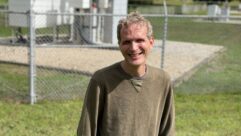Recently Radio World had an article by Ernesto Aguilar that discussed changing views of what “community radio stations” are [see radioworld.com/aguilar href=”https://www.radioworld.com/aguilar”]. Following up on that, I thought your readers might be interested in learning about an online archive where examples of programs and other artifacts of Lorenzo Milam’s station KRAB can be heard and viewed.

The KRAB Archive can be found at www.krab.fm. It has been 32 years since KRAB(FM), 107.7 Seattle, went off the air. Even after going silent, every so often an article or story would appear in the press describing KRAB and the exploits of founder Lorenzo Milam almost mythically. Friends would share these with me, knowing I would take exception to some part of it. It wasn’t that there was anything all that objectionable in the articles, it was simply that my memories of the station were still as vivid as ever, and the stories conveyed by the authors seemed, to me, to lack authenticity. The articles were being written by individuals that had never listened to KRAB.
Finally, at the end of 2012, I decided that rather than reacting to what I read, I would “set the record straight” and try to document in some public and authoritative way what I remembered of KRAB. Some of it is a reflection of my memories, but there is also a collection of artifacts, ephemera and whatever else I have found that contributes to conveying what was special about KRAB.
Briefly, KRAB was the fourth listener-supported station in the country, going on the air in December 1962, licensed to Lorenzo W. Milam, and transferred to the nonprofit Jack Straw Memorial Foundation in 1964. While KRAB broadcast on a commercial channel, it was a noncommercial nonprofit enterprise.
The operators did not seek a particularly wide audience, or even a livable wage. Programming policy was summarized in the frequently repeated mantra “KRAB will broadcast programming that other stations will not, or are unable to air.” They hoped a sufficient number of listeners would value a radio station making that promise, and would then be willing to support it with a $12 per year “subscription.”
KRAB sounded different. The volunteer announcers were told to speak normally, as if they were in the same room as the listener. They sometimes stumbled over unfamiliar languages and names. At KRAB we weren’t afraid of dead air: Silence was considered a tool that if used judiciously would enable listeners to transition from one genre of programming to another. Silence was preferable to filling the air with meaningless babble.

The photo is from a late 1960s fundraising brochure. From left: Gary Margason, a KRAB founder; Nancy Keith, program director; Steve Menasian, engineer; and Mary Siegel, volunteer. That’s a Neumann U 87 hanging below the fake Tiffany. The listeners were university professors, artists, poets, housewives (this was the ’60s) eager for something besides queen for a day, and teenagers older than their years. More than one person has characterized KRAB as their “graduate school.” Listeners were cautioned that no one was expected to listen, and “like,” everything on KRAB, except perhaps the station manager and program director. KRAB published a program guide so listeners could pick and choose what and when they would find something to their liking. There were a few, like myself, who enjoyed the juxtaposition of programs that provided an element of surprise, and appreciated the after-the-fact awareness of realizing they were learning something by accident and whimsy.
The archive started with a few of my own tapes and program guide copies. It has grown with the addition of digital copies made by the Jack Straw Foundation, the former licensee, programs from institutional collections, copies saved by former KRAB producers, recordings made off-the-air by listeners, and dubs circulated amongst “KRAB Nebula” stations.
People can now hear and see for themselves what it was that made KRAB unique. The programs in the archive range from the silly to the profound. There are examples of voice, music and ideas that were heard on only a very few radio stations across the country. There are even examples of “programmed silence.” Some worked, and some didn’t.
It is my hope the archive will help the curious, and young, understand that just because most media have chosen formulaic and monolithic programming formats, there can still be room for radio stations to be less constrained. The archive is a testament to the efforts of the former staff, volunteers and supporters of KRAB who demonstrated what can be done with a radio frequency and imagination.
The KRAB Archive can be found at www.krab.fm.
Comment on this or any story to[email protected].
The author started listening to KRAB in late 1963 and volunteered the next year. He served as program director, station manager, board trustee and president at various times.












